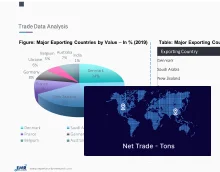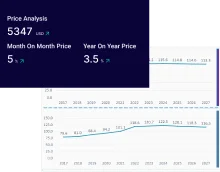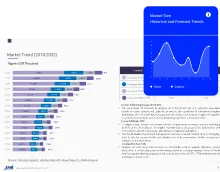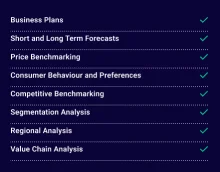
Consumer Insights
Uncover trends and behaviors shaping consumer choices today
Procurement Insights
Optimize your sourcing strategy with key market data
Industry Stats
Stay ahead with the latest trends and market analysis.
Australia real estate market value reached around USD 141.41 Billion in 2025, driven by robust demand for residential properties. Recovering of economy has led to a surge in housing demand, particularly in major cities like Sydney, Brisbane, and Perth, where property values have reached record highs. Additionally, low interest rates and favourable lending conditions have made homeownership more accessible, further fuelling market activity. As a result, the industry is expected to grow at a CAGR of 3.60% during the forecast period of 2026-2035 to attain a value of USD 201.41 Billion by 2035. Government incentives and infrastructure developments are also expected to stimulate investment in real estate.
Base Year
Historical Period
Forecast Period
In 2020, approximately 41,000 individuals were employed in property management across Australia, reflecting a significant segment of the workforce dedicated to overseeing residential and commercial properties. This sector has seen consistent growth, with property managers typically working around 43 hours per week. The median salary for these professionals stands at about AUD 51,000, supplemented by bonuses and commissions, indicating a competitive compensation structure that attracts talent to the industry. Notably, women constitute around 67% of the workforce in property management, highlighting the sector's inclusivity.
Australia's real estate landscape is dominated by several notable companies, including Hauss Pty Ltd., McKean McGregor Pty Ltd., Harris Real Estate Pty Limited, and McGrath Limited. These firms play a crucial role in shaping market trends and providing services that cater to the growing demand for residential and commercial properties.
The total value of residential properties in Australia experienced a remarkable surge from USD 512.6 billion to approximately USD 9,901.6 billion by December 2021. This dramatic increase underscores the robust recovery and expansion of the Australia real estate market, driven by factors such as low interest rates, increased consumer confidence, and a shift towards suburban living.
Compound Annual Growth Rate
3.6%
Value in USD Billion
2026-2035
*this image is indicative*
| Australia Real Estate Market Report Summary | Description | Value |
| Base Year | USD Billion | 2025 |
| Historical Period | USD Billion | 2019-2025 |
| Forecast Period | USD Billion | 2026-2035 |
| Market Size 2025 | USD Billion | 141.41 |
| Market Size 2035 | USD Billion | 201.41 |
| CAGR 2019-2025 | Percentage | XX% |
| CAGR 2026-2035 | Percentage | 3.60% |
| CAGR 2026-2035 - Market by Region | New South Wales | 4.0% |
| CAGR 2026-2035 - Market by Region | Victoria | 3.7% |
| CAGR 2026-2035 - Market by Property | Residential | 3.9% |
| CAGR 2026-2035 - Market by Mode | Online | 5.6% |
| 2025 Market Share by Region | Victoria | 25.3% |
The market growth is dependent on interest rates, which have a significant impact on housing prices. Lower interest rates stimulate demand for residential real estate as borrowing becomes more affordable, leading to price increases. The Reserve Bank of Australia's monetary policy decisions on interest rates have a direct influence on the housing market's performance. Economic growth is another crucial factor influencing the Australia real estate demand. During periods of economic expansion, rising incomes boost people's purchasing power for homes, driving up property prices. Conversely, economic downturns and recessions can lead to job losses, reduced incomes, and decreased demand for housing, resulting in lower property prices.
Additionally, certain areas of Australia are experiencing higher demand for real estate due to factors like better employment opportunities, quality schools, amenities, and rapid infrastructure developments. Moreover, the increased immigration of international students has driven the need for more housing in Australia, which is positively influencing market development.
Anticipated changes in monetary policy, growth of the rental market, and rising new investments are the key trends propelling the market growth.
Anticipated changes in monetary policy, such as potential interest rate cuts, are expected to impact the housing market positively. Lower interest rates could enhance borrowing capacity for buyers, stimulating demand and possibly leading to an increase in property prices later in 2024. Economists from major banks, including Westpac and NAB, predict that the RBA will implement its first interest rate cut as early as May 2025, with some forecasts suggesting a cut could occur in February 2025, further boosting Australia real estate market value. A rate cut of 0.25 to 0.5 percentage points could significantly enhance borrowing capacity for homebuyers, fuelling demand in the housing market. According to an analysis from Ray White Economics, a drop in interest rates could lead to an average increase in property prices of nearly USD 15,000 in cities like Sydney and Melbourne within the first month following a rate cut. The overall property values across Australia could rise by approximately 0.6%, adding about USD 5,000 to the average property price.
The rental market has seen a significant rise, with combined capital house rents rising by 5% in early 2024, marking the steepest quarterly gain in 17 years. This growth of Australia real estate market is attributed to a supply-demand imbalance, with ongoing pressure on rental prices as vacancy rates remain low. According to Domain's March quarter 2024 Rent Report, the median asking rent for houses in Australia’s combined capital reached USD 630 per week, up from previous quarters. This increase reflects rising demand amid limited housing supply. As per the most recent information provided by CoreLogic, rental prices experienced a modest increase of 0.2 per cent during October 2024. Concurrently, the national vacancy rate rose to 1.8 per cent, reflecting a 40-basis-point rise from the previous record low of 1.4 per cent noted at the same period last year.
While some existing investors are affected by high interest rates and increased holding costs, new investment purchases are on the rise. Investor loan commitments increased by 18.8% over the past year, particularly in high-growth markets like Queensland and Western Australia, which increases the Australia real estate market revenue. As per the latest Mortgage Insights report from Money.com.au., Queensland has emerged as a significant player in the investment market, accounting for 23.4% of new investor loans, surpassing Victoria for the first time in nearly two decades. The state saw 4,593 new investor loan commitments, indicating a robust demand driven by factors such as infrastructure development and lifestyle appeal. A survey conducted by the Australian Property Investor (API) indicated that Queensland, Western Australia, and New South Wales are solidifying their positions as leading property markets for investors, capturing three-quarters of respondents' interest.
The real estate market in Australia is poised for significant changes due to anticipated interest rate cuts by the Reserve Bank of Australia (RBA) in 2025. Experts predict that the RBA will implement multiple small cuts in the second half of the year, depending on inflation trends and overall economic performance. As inflation stabilises within the RBA's target range, these cuts are expected to enhance borrowing capacity for potential homebuyers. This is particularly relevant in major markets like Sydney and Melbourne, where higher mortgage sizes make buyers sensitive to interest rate fluctuations. Recent data indicated that property prices in Sydney rose by 2.3% at the end of 2024, while Melbourne experienced a decline of 3%. This divergence illustrates how interest rates can significantly influence buyer behaviour and market dynamics.
Australia's population growth, driven by immigration, continues to influence housing demand significantly. As of September 2024, with annual arrivals reaching between 350,000 and 400,000 people, there is sustained pressure on housing markets, particularly in metropolitan areas where new arrivals typically settle. This demographic shift is prompting investors to consider the preferences of migrant populations when identifying lucrative Australia real estate market opportunities in rental properties and new developments.
Immigrants tend to be disproportionately young adults, which further increases demand for housing, particularly in metropolitan areas like Sydney and Melbourne where job prospects are more favourable. Approximately half of the growth in households in Melbourne is attributed to overseas migration, underscoring its critical role in shaping housing demand. Moreover, a report from Forecast indicated that Australia’s migrant population would grow by more than 700,000 between the 2022 and 2024 financial years.
Australia is currently experiencing an alarmingly low level of new housing supply, with the Urban Development Institute of Australia (UDIA) reporting that housing supply remains at near-decade lows while demand is at record highs. The UDIA Housing Index indicates that supply is 12% below the long-run average and 21% below peak performance, leading to increased pressure on both property prices and rental availability.
The construction sector is facing challenges from rising expenses due to inflation in construction materials and a scarcity of labour, impacting Australia real estate demand growth. The elevated costs associated with construction are discouraging developers from launching new initiatives, thereby worsening the current deficit in housing supply. Numerous projects have turned financially impractical due to heightened borrowing costs and operational expenditures, resulting in postponements or cancellations of new housing developments.
“Australia Real Estate Market Report and Forecast 2026-2035” offers a detailed analysis of the market based on the following segments:
Market Breakup by Property
Market Breakup by Business
Market Breakup by Region
| CAGR 2026-2035 - Market by | Region |
| New South Wales | 4.0% |
| Victoria | 3.7% |
| Queensland | XX% |
| Australian Capital Territory | XX% |
| Western Australia | XX% |
| Others | XX% |
Market Insights by Property
Australia real estate industry analysis based on residential, commercial, and industrial properties states that the residential real estate sector caters to housing needs and is impacted by shifts in population, family size, economic conditions, and government policies. Industrial real estate, especially logistics properties, is witnessing substantial growth in Australia. The value of industrial property is surpassing office property values due to the surge in e-commerce demand. Annual rental growth for logistics properties has been robust, attracting global capital investments and driving down yields. The strategic importance of large distribution centres and infrastructure developments are key drivers in the industrial property segment.
Market Insights by Business
The sales segment accounts for a significant market share as it benefits from both owner-occupiers and investors looking to capitalise on property appreciation, particularly in major cities like Sydney and Melbourne where demand remains high and influences Australia real estate market dynamics and trends. Many investors are further actively seeking residential properties as a means of generating rental income and capital growth. This interest in property investment drives sales volumes, as investors purchase homes not just for personal use but also as part of their investment portfolios.
Conversely, the rental segment is gaining traction as more individuals now opt to rent rather than buy. Demand for rental properties is increasing in urban areas due to decreasing affordability. Attached dwellings like apartments and townhouses are becoming popular among renters seeking proximity to amenities. Additionally, regional markets are emerging as attractive alternatives for those seeking lifestyle benefits outside major cities.
New South Wales Real Estate Market Trends
New South Wales (NSW) remains a dominant force in the market, particularly driven by Sydney's robust property landscape. Despite facing challenges such as high interest rates and affordability issues, the demand for housing continues to outstrip supply, impacting the Australia real estate demand forecast. The median house price in Sydney has seen fluctuations but remains around USD 1.2 million, reflecting its status as a sought-after location.
Victoria Real Estate Market Opportunities
Victoria's real estate market is characterised by a significant demand-supply imbalance, particularly in Melbourne, where rental prices have surged by 5% in early 2024, the highest quarterly increase in 17 years, which can increase the Australia real estate industry revenue. The Victorian government has introduced policies aimed at increasing housing supply, such as a 12-month reduction in stamp duty for off-the-plan units and the identification of 50 new activity centres to streamline development approvals.
Queensland Real Estate Market Growth
Queensland's property market accounts for a significant Australia real estate market share and is experiencing robust growth, with house prices rising by 2.07% and units by 5.09% over the first quarter of 2024. The state's appeal is bolstered by its relatively affordable housing compared to other states and a strong influx of interstate migrants seeking lifestyle changes. The Real Estate Institute of Queensland reports that units have increased by 10.2% annually, highlighting their popularity among buyers.
Western Australia Real Estate Market Dynamics
Western Australia (WA) is currently experiencing a dynamic real estate market characterised by significant growth in property values and strong demand. As of late 2024, Perth's median house price is projected to reach approximately USD 750,000, reflecting a remarkable increase of 25% over the year, which increases Australia real estate market opportunities. The state government’s initiatives, such as the Vacant Property Rental Incentive Scheme, aim to alleviate housing shortages by encouraging property owners to rent out their homes. Despite challenges like rising interest rates and construction costs.
Startups are leveraging AI and big data to provide insights throughout the property development process, helping stakeholders make informed decisions regarding feasibility and compliance. Additionally, the Australian Proptech Summit serves as a platform for these startups in Australia real estate industry to showcase their solutions and connect with industry leaders. The summit highlights the importance of technology in navigating evolving tenant expectations.
Downsizer
Downsizer is an innovative startup that operates at the intersection of FinTech, PropTech, and InsureTech. Founded in 2016, the platform is designed to assist senior property owners in Australia who wish to transition to a new home without selling their existing property or depleting their savings. It allows users to acquire new properties with zero cash deposits by enabling them to back a deposit bond using the equity from their current home.
Archistar
Archistar, founded in 2019, is a PropTech startup that leverages AI and machine learning to streamline the property development process. The platform offers tools for feasibility analysis, site selection, and compliance checks, helping developers make informed decisions quickly. By integrating data analytics into real estate development, the company enhances efficiency and reduces risks associated with property investment.
Market players are engaged in acquisitions to expand their real estate, enter international markets, and stay ahead in the competition. Companies in Australia real estate industry are actively adapting to changing economic conditions and consumer preferences, focusing on various strategies to drive growth and meet demand. Additionally, real estate companies are leveraging technology to improve customer engagement and streamline transactions. The use of digital platforms for property listings, virtual tours, and online auctions has become more prevalent.
Hauss Pty Ltd. also referred to as Haas Investments Pty Ltd, is a foreign-owned proprietary company based in Australia, primarily engaged in hop growing and marketing services. Haas Investments derives its revenue from the production and marketing of hops, which are essential for the brewing industry.
The Agency is an innovative real estate firm based in Sydney, Australia, that aims to redefine the traditional real estate agency model. The company operates both in-store and online real estate services across the country, providing a comprehensive platform for buying, selling, and renting properties.
McKean McGregor Pty Ltd. is a well-established, locally owned real estate agency based in Central Victoria, Australia, with over 100 years of experience in the industry. Founded in 1911, the company has built a strong reputation for providing personalised customer service across various sectors, including residential and commercial real estate.
*Please note that this is only a partial list; the complete list of key players is available in the full report. Additionally, the list of key players can be customized to better suit your needs.*
Other players in the Australia real estate market are Harris Real Estate Pty Limited, McGrath Limited, eXp Australia Pty Ltd., CBRE Pty Limited, and Luxury Real Estate Agents, among others.
United Kingdom Real Estate Market
North America Real Estate Market
United States Real Estate Market
Canada Real Estate Market
Europe Real Estate Market
India Real Estate Market
Italy Real Estate Market
Real Estate Market




*While we strive to always give you current and accurate information, the numbers depicted on the website are indicative and may differ from the actual numbers in the main report. At Expert Market Research, we aim to bring you the latest insights and trends in the market. Using our analyses and forecasts, stakeholders can understand the market dynamics, navigate challenges, and capitalize on opportunities to make data-driven strategic decisions.*
Get in touch with us for a customized solution tailored to your unique requirements and save upto 35%!
The Australia real estate market is assessed to grow at a CAGR of 3.60% between 2026 and 2035.
Rising population, increasing disposable income, and rapid infrastructure development are some of the major factors propelling the growth of the market.
Key trends aiding the market expansion are availability of favourable government regulations, increasing demand for affordable housing, and emergence of green building practises.
Regions considered in the market are South Wales, Victoria, Queensland, Western Australia, and Australian Capital Territory, among others.
The real estate market is categorised according to property, which includes residential, commercial, industrial and land.
The market is divided into types, which include sales, rental, and lease.
Key players in the market are Hauss Pty Ltd., The Agency, McKean McGregor Pty Ltd., Harris Real Estate Pty Limited, McGrath Limited, eXp Australia Pty Ltd., CBRE Pty Limited, and Luxury Real Estate Agents, among others.
In 2025, the market reached an approximate value of USD 141.41 Billion.
The market is estimated to witness healthy growth in the forecast period of 2026-2035 to reach a value of around USD 201.41 Billion by 2035.
Explore our key highlights of the report and gain a concise overview of key findings, trends, and actionable insights that will empower your strategic decisions.
| REPORT FEATURES | DETAILS |
| Base Year | 2025 |
| Historical Period | 2019-2025 |
| Forecast Period | 2026-2035 |
| Scope of the Report |
Historical and Forecast Trends, Industry Drivers and Constraints, Historical and Forecast Market Analysis by Segment:
|
| Breakup by Property |
|
| Breakup by Business |
|
| Breakup by Region |
|
| Market Dynamics |
|
| Competitive Landscape |
|
| Companies Covered |
|
Datasheet
One User
USD 2,499
USD 2,249
tax inclusive*
Single User License
One User
USD 3,999
USD 3,599
tax inclusive*
Five User License
Five User
USD 4,999
USD 4,249
tax inclusive*
Corporate License
Unlimited Users
USD 5,999
USD 5,099
tax inclusive*
*Please note that the prices mentioned below are starting prices for each bundle type. Kindly contact our team for further details.*
Flash Bundle
Small Business Bundle
Growth Bundle
Enterprise Bundle
*Please note that the prices mentioned below are starting prices for each bundle type. Kindly contact our team for further details.*
Flash Bundle
Number of Reports: 3
20%
tax inclusive*
Small Business Bundle
Number of Reports: 5
25%
tax inclusive*
Growth Bundle
Number of Reports: 8
30%
tax inclusive*
Enterprise Bundle
Number of Reports: 10
35%
tax inclusive*
How To Order

Select License Type
Choose the right license for your needs and access rights.

Click on ‘Buy Now’
Add the report to your cart with one click and proceed to register.

Select Mode of Payment
Choose a payment option for a secure checkout. You will be redirected accordingly.
Gain insights to stay ahead and seize opportunities.

Get insights & trends for a competitive edge.

Track prices with detailed trend reports.

Analyse trade data for supply chain insights.

Leverage cost reports for smart savings

Enhance supply chain with partnerships.

Connect For More Information
Our expert team of analysts will offer full support and resolve any queries regarding the report, before and after the purchase.
Our expert team of analysts will offer full support and resolve any queries regarding the report, before and after the purchase.
We employ meticulous research methods, blending advanced analytics and expert insights to deliver accurate, actionable industry intelligence, staying ahead of competitors.
Our skilled analysts offer unparalleled competitive advantage with detailed insights on current and emerging markets, ensuring your strategic edge.
We offer an in-depth yet simplified presentation of industry insights and analysis to meet your specific requirements effectively.
Share